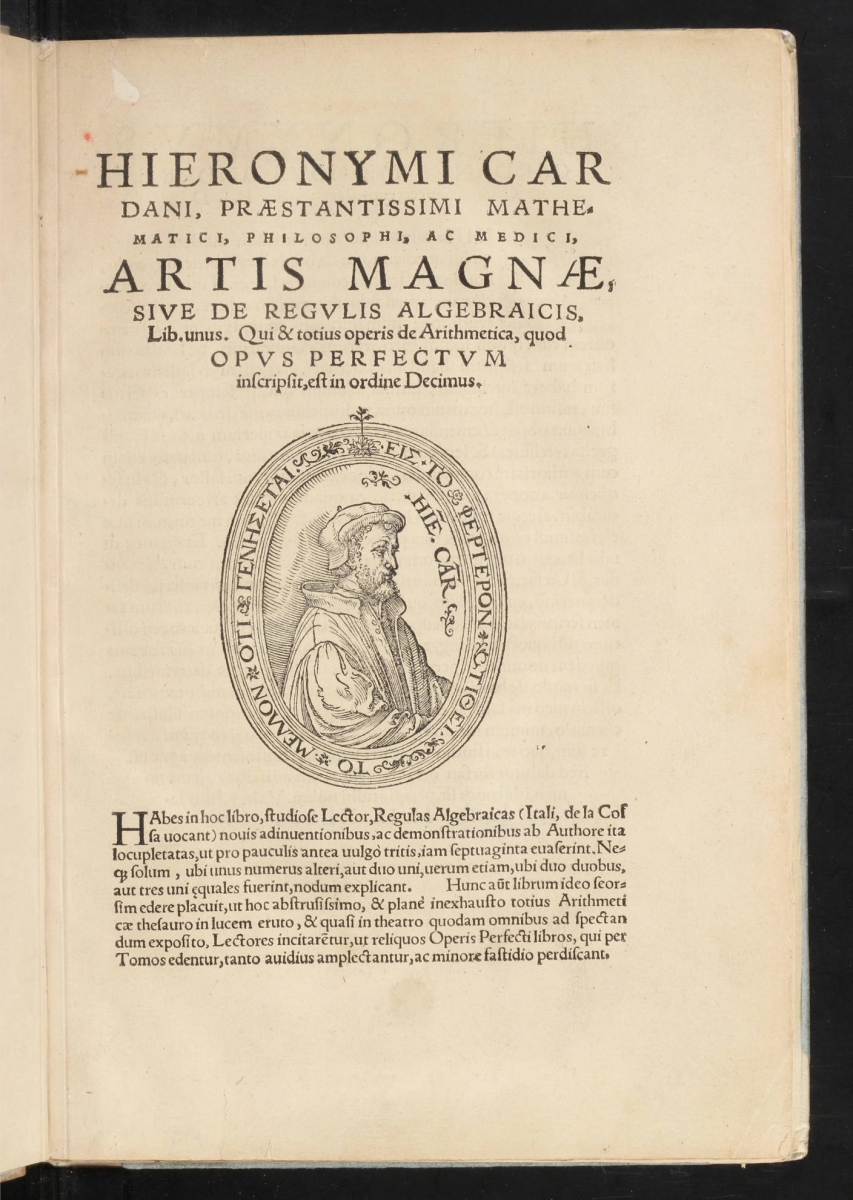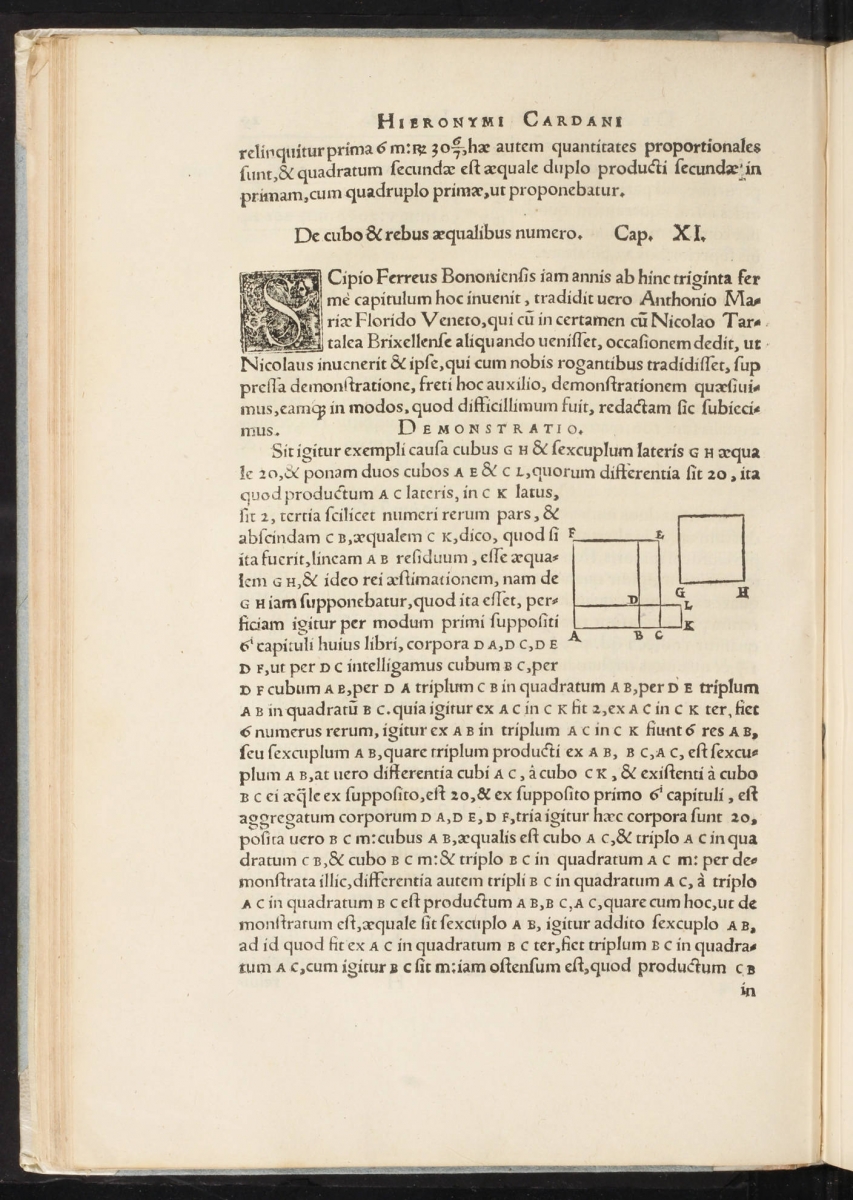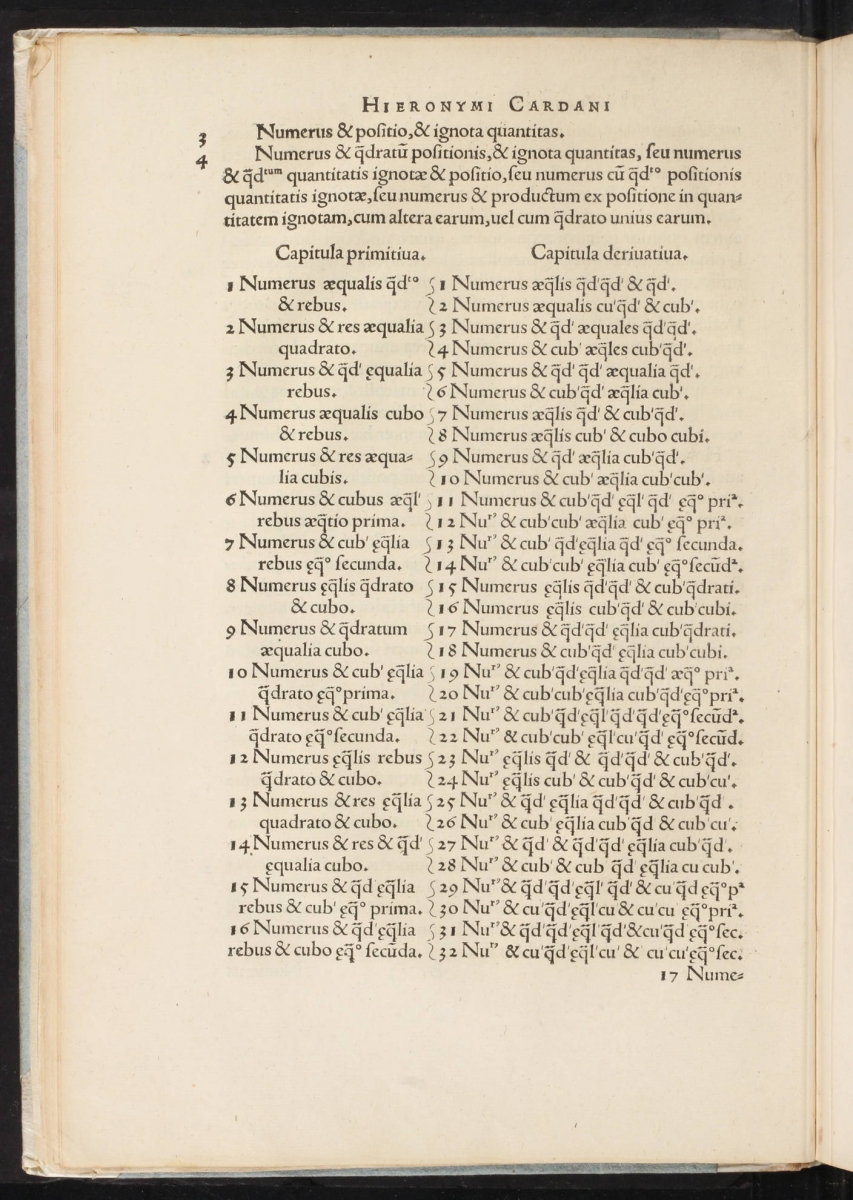- About MAA
- Membership
- MAA Publications
- Periodicals
- Blogs
- MAA Book Series
- MAA Press (an imprint of the AMS)
- MAA Notes
- MAA Reviews
- Mathematical Communication
- Information for Libraries
- Author Resources
- Advertise with MAA
- Meetings
- Competitions
- Programs
- Communities
- MAA Sections
- SIGMAA
- MAA Connect
- Students
- MAA Awards
- Awards Booklets
- Writing Awards
- Teaching Awards
- Service Awards
- Research Awards
- Lecture Awards
- Putnam Competition Individual and Team Winners
- D. E. Shaw Group AMC 8 Awards & Certificates
- Maryam Mirzakhani AMC 10 A Awards & Certificates
- Two Sigma AMC 10 B Awards & Certificates
- Jane Street AMC 12 A Awards & Certificates
- Akamai AMC 12 B Awards & Certificates
- High School Teachers
- News
You are here
Mathematical Treasure: Cardano's Ars Magna
Renaissance man Gerolamo Cardano was a physician, mathematician, gambler, and writer. Cardano’s Ars Magna, published in 1545, is often considered the start of a comprehensive theory for solving algebraic equations. It was actually the tenth in a series of volumes Cardano wrote for a work he called Opus Perfectum, or The Perfect Work. Here is the title page:

Although he didn’t claim to be the first to come up with the techniques in the Ars Magna, Cardano was the first to publish a compilation of the known methods for solving polynomial equations up through degree four. In fact, there are places in the book where he gave credit to the originator of a particular method (e.g., Tartaglia). The page below (folio 29 verso) shows the start of Chapter XI, About the Cube and First Power Equal to a Number. The first paragraph, as translated by T. Richard Witmer, reads, “Scipio Ferro of Bologna well-nigh 30 years ago discovered this rule and handed it on to Antonio Maria Fior of Venice, whose contest with Niccolo Tartaglia of Brescia gave Niccolo occasion to discover it. He [Tartaglia] gave it to me in response to my entreaties, though withholding the demonstration. Armed with this assistance, I sought out its demonstration in [various] forms. This was very difficult. My version follows.”

Cardano did not write the general form for a quadratic equation as we do, namely \[ax^2 + bx + c = 0\] but instead only allowed positive coefficients and solutions. Thus, it took four different cases to include all possible quadratic equations. Three of the cases are #1–3 in the table below from Chapter II, About the Total Number of Rules. In English, these three cases are a number equal to a square and a linear term, a number and a linear term equal to a square, and a number and a square equal to a linear term. The case of a number equal to a square term was mentioned on the previous page. A possible activity in a high school or college algebra class would be to have students write these cases in modern notation and investigate why Cardano had these, and only these, four cases for quadratic equations.

Using his techniques, Cardano encountered a square root of a negative integer while solving a certain quadratic equation. Specifically, the problem was to find two numbers whose sum is 10 and product 40. The corresponding quadratic equation in modern notation is \[x^2 - 10x + 40 = 0\] For Cardano, this problem would have the form of a number and a square equal to a linear term. In his explanation, Cardano, writing in Latin dismissis incruciationibus, ignored the fact that there are negative radicands in the resulting two numbers, and he proceeded to show that the product of the two numbers, namely \[5 + \sqrt{-15}\] and \[5 - \sqrt{-15}\] was indeed 40. The phrase “dismissis incruciationibus” has been translated in different ways. In the Witmer translation (p. 219), it is “putting aside mental tortures” with an alternative translation of “the cross-multiples having canceled out” in a footnote, while Vera Sanford translated it as “the imaginary part being lost” (Smith, p. 202). The image (folio 66) below shows the corresponding page from Ars Magna.

More on Cardano’s methods for solving cubic and quartic equations can be found in the Convergence articles “Solving the Cubic with Cardano” and “A Modern Vision of the Work of Cardano and Ferrari on Quartics”.
For another image of the title page of Cardano’s Ars Magna, visit the page “Mathematical Treasures - Ars Magna Title Page” by Frank J. Swetz and Victor J. Katz in Convergence.
A complete digital scan of Ars Magna, call number QA35.C35 1545, can be found at https://catalog.lindahall.org/discovery/delivery/01LINDAHALL_INST:LHL/1286504780005961.
Images in this article are courtesy of the Linda Hall Library of Science, Engineering & Technology and used with permission. The Linda Hall Library makes available all existing digital images from its collection that are in the public domain to be used for any purpose under the terms of a Creative Commons License CC by 4.0. The Library’s preferred credit line for all use is: “Courtesy of The Linda Hall Library of Science, Engineering & Technology.”
References
Branson, William B. "Solving the Cubic with Cardano." Convergence (September 2013). http://www.maa.org/press/periodicals/convergence/solving-the-cubic-with-cardano.
Helfgott, Harald, and Michel Helfgott. "A Modern Vision of the Work of Cardano and Ferrari on Quartics." Convergence (February 2010), DOI:10.4169/loci003312. http://www.maa.org/press/periodicals/convergence/a-modern-vision-of-the-work-of-cardano-and-ferrari-on-quartics-introduction.
O'Connor, J. J., and E. F. Robertson. “Girolamo Cardano.” MacTutor History of Mathematics archive. http://www-history.mcs.st-and.ac.uk/Biographies/Cardan.html.
Smith, David Eugene. A Source Book in Mathematics. Dover, 1959.
Swetz, Frank J., and Victor J. Katz. “Mathematical Treasures – Ars Magna Title Page.” Convergence (January 2011). http://www.maa.org/press/periodicals/convergence/mathematical-treasures-ars-magna-title-page.
Witmer, T. Richard, trans. Ars Magna or the Rules of Algebra. MIT Press, 1968. Reprint, Dover, 1993.
Cynthia J. Huffman (Pittsburg State University), "Mathematical Treasure: Cardano's Ars Magna," Convergence (January 2017)




